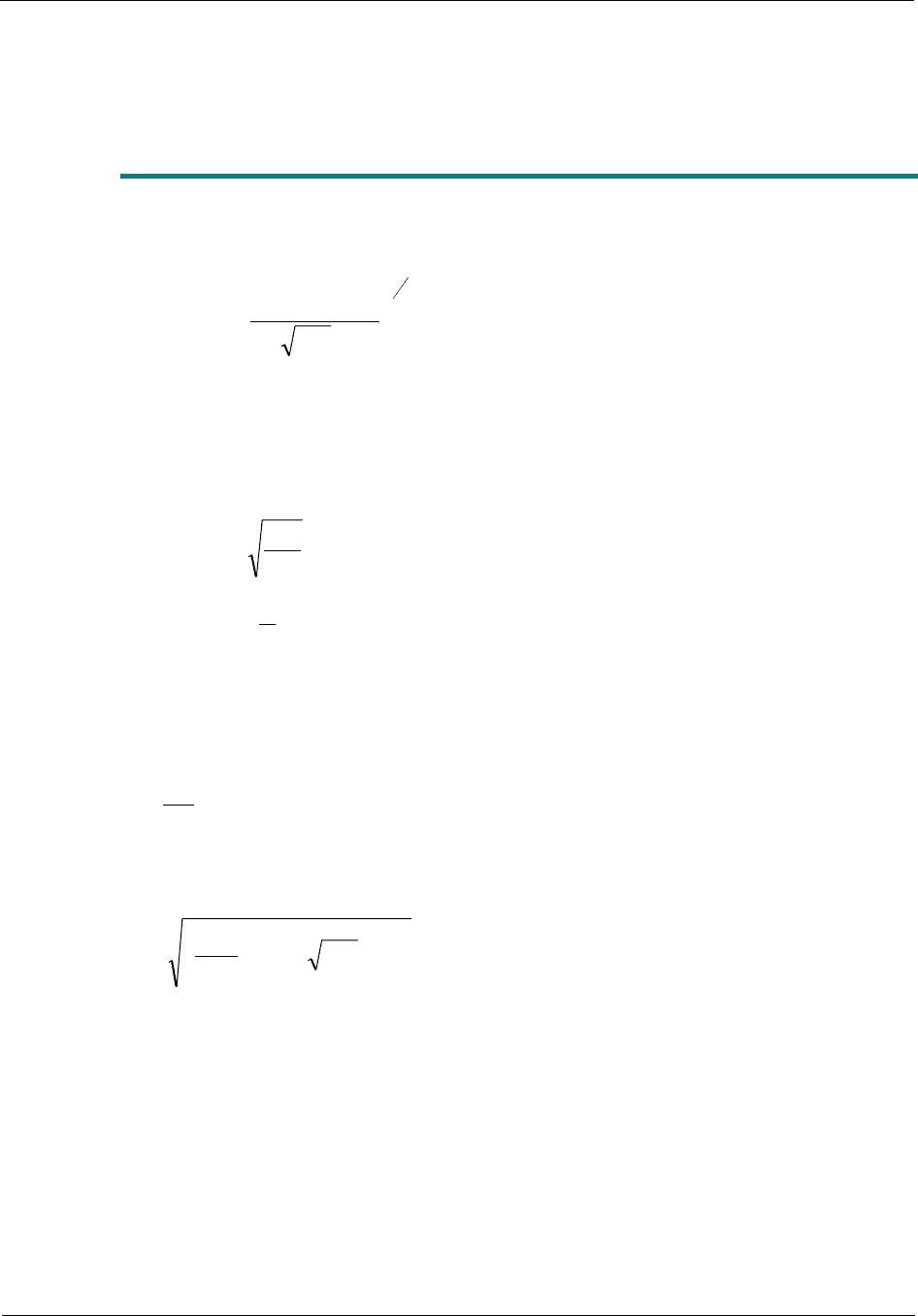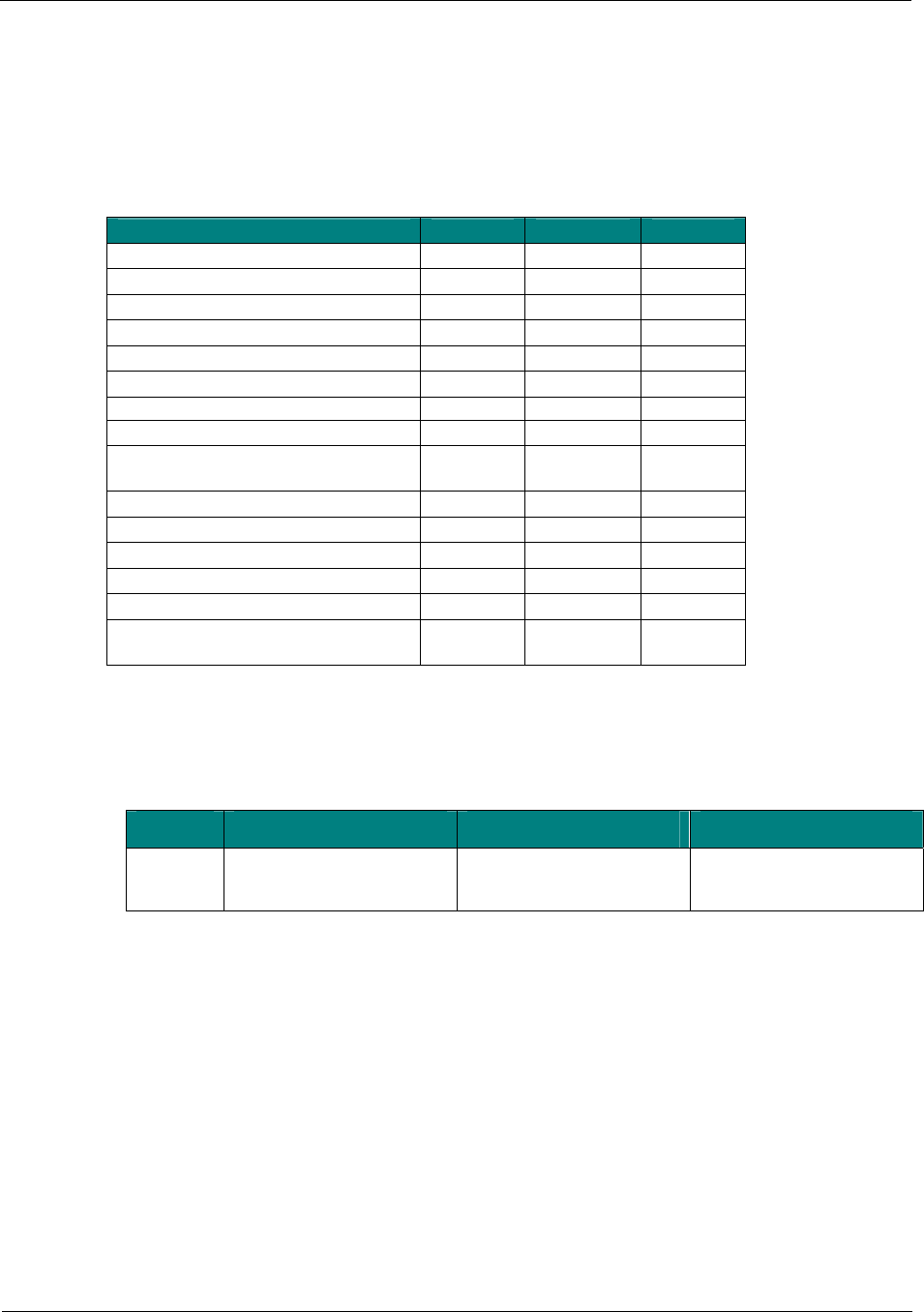FIRE protection found. Пожарная безопасность театров
Подождите немного. Документ загружается.


Client Fire Safety in Theaters – A New Design Approach
Part I Assessment of Fire Safety Measures in Proscenium Theaters
s
F:\06 PROJECTS\CURRENT PROJECTS\076040-49 THEATER PROJECT
DTX\REPORT\076040-49_THEATRE_R_20090910.DOC
Page G1/2
Ove Arup & Partners Consulting Engineers PC
10 September 2009
G1 Estimates of Radiative Heat Flux and Resultant
Duration of Tolerance
G1.1 Methodology
The point source radiation model [1] is as follows:
2
4
R
Q
q
r
r
π
=
′′
where
r
q
′′
,
r
Q , and
R
are respectively the radiative heat flux in kw/m³, radiative heat release
rate in kW, and the distance from the midpoint of a “flame” a target.
Heskestad’s flame height correlation [2] is employed to estimate a flame height as follows:
5/2
235.002.1 QDH
f
+−=
where
Q and D are respectively the total heat release rate in kW and the diameter of fire.
Purser [3] provides the following correlation with regard to the time to burning or skin due to
the radiant heat:
33.1
80
q
t
Irad
=
where
Irad
t is the tolerance time in seconds. Purser [3] also states that the radiative heat
flux of 2.5 kw/m² or below can be tolerated for more than 5 minutes.
G1.2 Assumptions and Input
The following assumptions and input have been used:
• A point source fire is assumed.
• The radiative fraction of heat release rate is assumed to be 0.35.
• The distance from the midpoint of a flame to a first row seat is employed (Table G1).
• Flame height(s) are estimated using Heskestad’s flame height correlation [2].
• The heat release rate was determined at the time of the activation time of the wall-
mounted rate-of-rise heat detector having the RTI value of 66 m
½
s
½
. plus 30 seconds,
corresponding to the maximum permissible time for the deployment of a fire safety
curtain..
• The diameter of a fire was obtained from the CFD models at the time of complete
deployment of a fire curtain.
• It is assumed that radiant heat is attenuated in passing through a fire curtain such that it
is well below the radiative heat flux of 2.5 kW/m² upon full deployment of a fire curtain.
• A fire occurring on the center of a stage (i.e., Fire Scenario 1) is considered to be the
most restrictive case due to its proximity to the seats.

Client Fire Safety in Theaters – A New Design Approach
Part I Assessment of Fire Safety Measures in Proscenium Theaters
s
F:\06 PROJECTS\CURRENT PROJECTS\076040-49 THEATER PROJECT
DTX\REPORT\076040-49_THEATRE_R_20090910.DOC
Page G2/2
Ove Arup & Partners Consulting Engineers PC
10 September 2009
G1.3 Results
The estimated radiative heat flux and the resultant tolerance time are shown in Table G1.
The results show that the occupants may be exposed to a radiative heat flux of 3.1 kW/m² or
higher, an exposure that could not be tolerated for more than 18 seconds. In the small- and
medium-sized theatres, the fire curtain is expected to close out the opening, prior to the
onset of untenable conditions in terms of the radiant heat. It is noted that the activation of
ceiling-mounted rate-of-rise heat detectors are not accounted for here.
Table G1 – Tolerance time of occupants in the auditorium under the estimated radiative heat
flux, prior to the complete deployment of a fire curtain.
Theatre
Perpendicular
distance from
fire to target [ft]
Flame
height
[ft]
Distance from
point source
fire to target [ft]
HRR
(kW)
Radiative
heat flux
(kW/m²)
Duration of
tolerance
(min)
Small
25.2 6.9
25.5 1020 0.47
More than
5
Medium
37.0 9.5
37.3 2790 0.60
More than
5
Large
45.3 17.0
46.1 22000 3.10 0.3
G2 References
[1] Drysdale, D., “An introduction to Fire Dynamics,” 2
nd
ed., John Wiley & Sons Ltd,
England, 2000.
[2] Heskestad, G., ”Fire Plumes, Flame Height, and Air Entrainment,” in the SFPE HB
3
rd
, 2002.
[3] Purser, D., “Toxicity Assessment of Combustion Products,” in the SFPE HB 3
rd
,
2002.

Client Fire Safety in Theaters – A New Design Approach
Part I Assessment of Fire Safety Measures in Proscenium Theaters
s
F:\06 PROJECTS\CURRENT PROJECTS\076040-49 THEATER PROJECT
DTX\REPORT\076040-49_THEATRE_R_20090910.DOC
Ove Arup & Partners Consulting Engineers PC
10 September 2009
Appendix H
Estimated Minimum
Fire Sizes Required to
Actuate Flytower
Sprinklers

Client Fire Safety in Theaters – A New Design Approach
Part I Assessment of Fire Safety Measures in Proscenium Theaters
s
F:\06 PROJECTS\CURRENT PROJECTS\076040-49 THEATER PROJECT
DTX\REPORT\076040-49_THEATRE_R_20090910.DOC
Ove Arup & Partners Consulting Engineers PC
10 September 2009
H1 Estimates of Minimum Fire Size for Sprinkler
Activation
H1.1 Methodology
The minimum fire size for triggering sprinklers provided in the stagehouse of the theatres
was estimated using the following correlation developed by MaCaffrey, Quintiere, and
Hackleroad [1]:
3
1
2
85.6
⎟
⎟
⎠
⎞
⎜
⎜
⎝
⎛
⋅=Δ
TkOO
AhHA
Q
T
&
[H1]
Where
T
Δ
,Q
&
,
O
A ,
O
H ,
k
h , and
T
A are respectively the temperature increase, the heat
release rate [kW], the opening of area [m²], the opening of height [m], the effective heat
conduction coefficient [kW(m²K)], and the total internal enclosure surface area [m²].
The term
k
h is defined as follows:
For t<t
p
,
t
ck
h
k
ρ
= [H2a]
For t>=t
p
,
δ
k
h
k
= [H2b]
Where
k
,
ρ
,
c
, and
δ
are the thermal conductivity [kW/(mK)], the density [kg/m³], specific
heat [kJ/(kgK)], and the thickness of the solid [m].
The t
p
is the thermal penetration time and can be given as:
t
p
α
δ
4
2
= [H3]
The term
α
is the thermal diffusivity in m²/s.
To estimate the minimum fire size, equation [1] is rearranged as follows:
()
TkOO
AhHA
T
Q ⋅
⎟
⎠
⎞
⎜
⎝
⎛
Δ
=
3
85.6
[H4]
Note that although the application of this correlation may not be appropriate for the theatre
stage where the ceiling height is much greater than an opening height, the intent of this
section is to provide an approximate estimate as to what minimum fire size would trigger
sprinklers provided in the stage.
H2 Assumptions and Input
The following assumptions have been made relative to minimum fire size calculations:
• A steady- state fire was assumed;
• A duration of fire is greater than the thermal penetration time (i.e., about 2.7 hrs);
• The theatre is constructed of concrete.

Client Fire Safety in Theaters – A New Design Approach
Part I Assessment of Fire Safety Measures in Proscenium Theaters
s
F:\06 PROJECTS\CURRENT PROJECTS\076040-49 THEATER PROJECT
DTX\REPORT\076040-49_THEATRE_R_20090910.DOC
Ove Arup & Partners Consulting Engineers PC
10 September 2009
• The sprinkler activation temperature is 74 °C.
• Sprinklers are assumed to actuate when the gas temperature under steady-state
conditions are greater than or equal to the activation temperature.
The inputs for the calculations are tabulated below:
Table H1 – Input parameters used for estimating the minimum steady-state fire size for
sprinkler activation
Parameters small medium large
thermal diffusivity[m²/s] 5.70E-07 5.70E-07 5.70E-07
thickness[m] 0.15 0.15 0.15
thermal conductivity[kW/mK] 0.0018 0.0018 0.0018
Penetration time[s] 9868 9868 9868
Density (rho) [kg/m³] 2280 2280 2280
specific heat [kJ/(kgK)] 1.04 1.04 1.04
k_rho_c[kW²s/(m
4
K²)] 4.27E+00 4.27E+00 4.27E+00
time[s] 600 600 600
effective heat conduction
coefficient[kW/(m²K)]
0.0120 0.0120 0.0120
opening area[m²] 59.7 77.1 171.9
opening height[m] 5.6 6.2 11.3
total enclosure surface area[m²] 1006.9 1677.5 3847.6
temperature rise[C or K] 55 55 55
Ambient temperature[C] 20 20 20
Sprinkler activation
temperature[C]
74 74 74
H3 Results
The minimum fire sizes for each of the theatre sizes are estimated based on the
assumptions contained herein are presented below:
small medium large
HRR
[kW]
~1000 ~1500 ~3800
H4 References
[1] McCaffrey, B., Quintiere, J., and Harkleroad, M., “Estimating Room Fire
Temperatures and the Likelihood of Flashover Using Fire Test Data Correlations,”
Fire Technology, V. 17, No. 2, pp. 98-119, 1981.

Client Fire Safety in Theaters – A New Design Approach
Part I Assessment of Fire Safety Measures in Proscenium Theaters
s
F:\06 PROJECTS\CURRENT PROJECTS\076040-49 THEATER PROJECT
DTX\REPORT\076040-49_THEATRE_R_20090910.DOC
Ove Arup & Partners Consulting Engineers PC
10 September 2009
Appendix I
CFD modeling

Client Fire Safety in Theaters – A New Design Approach
Part I Assessment of Fire Safety Measures in Proscenium Theaters
s
F:\06 PROJECTS\CURRENT PROJECTS\076040-49 THEATER PROJECT
DTX\REPORT\076040-49_THEATRE_R_20090910.DOC
Page I1/3
Ove Arup & Partners Consulting Engineers PC
10 September 2009
I1 Overview
Fire Dynamics Simulator (FDS) versions 5.2.4 [1] has been used to evaluate the activation
or deployment of fire protection systems often or required to be provided in proscenium
theatres. Since the first version of FDS released in 2000 by the National Institute Standards
and Technology (NIST), it has been widely used and validated rigorously by the fire
protection engineering community. Solving the form of Navier-Stokes equations appropriate
for low march number flows, FDS is specifically developed for simulating the gas phase fire
environment of scenarios by giving emphasis on heat and smoke flows from fires.
I2 Governing Equations
I2.1 Governing Equations
I2.1.1 Hydrodynamic Model
Conservation of mass, conservation of momentum, the divergence of velocity (conservation
of energy), the ideal gas law, and conservation of mixture fraction are used in FDS [1].
I2.1.2 Turbulence Model
There are two options to solve for the viscosity: Large Eddy Simulation (LES) and Direct
Numerical Simulation (DNS) [1]. For most large domain applications, a DNS is not currently
practical to apply due to the high computational cost. In LES, large eddies are directly
computed using Navier-Stokes equations while small eddies are modeled. FDS uses the
Smagorinsky sub grid scale (SGS) model to represent small eddy motion.
I2.1.3 Combustion Model
Two combustion models are embedded in FDS: finite-rate reaction and mixture fraction
combustion. If a DNS calculation is invoked, it is appropriate to employ finite-rate reaction.
Otherwise, a mixture fraction combustion model is appropriate to apply.
If the chemical reaction is assumed to be infinitely fast, all the parameters related to finite-
rate chemical kinetics can be eliminated. From this assumption, “mixture fraction”
representing the fraction of material at a certain point and time originated in the fuel stream
is introduced. This “conserved scalar” parameter, mixture fraction, is able to reduce the
computation time significantly.
The mass fractions for each species can be expressed with regards to the mixture fraction.
These correlations are called “state relations”. A mixture fraction (Z) of 1 indicates the pure
fuel while ambient air is represented by 0. Once appropriate amount of oxygen and fuel
exist in one cell, a flame is formed and combustion occurs.
I2.1.4 Thermal Radiation Model
Soot that is generated from most fire cases dominates the thermal radiation from fire and
hot gas layers. For all but lightly sooting fuels, it is possible to treat the gas as a gray
medium (independent of wavelength) since soot has a continuous radiation spectrum and
can be considered a non-scattering material. The mean absorption coefficient can be
reasonably used. The Radiation Transport Equation for a non-scattering gray gas is:
()
)()( SiSia
dS
id
b
′
−
′
=
′
[E1]
Where bandSi ,,, denote the radiation intensity, coordinate along the path of
radiation, the absorption coefficient, and blackbody radiant intensity, respectively.
The source term is given by blackbody radiation intensity:

Client Fire Safety in Theaters – A New Design Approach
Part I Assessment of Fire Safety Measures in Proscenium Theaters
s
F:\06 PROJECTS\CURRENT PROJECTS\076040-49 THEATER PROJECT
DTX\REPORT\076040-49_THEATRE_R_20090910.DOC
Page I2/3
Ove Arup & Partners Consulting Engineers PC
10 September 2009
4
Ti
b
π
σ
=
′
[E2]
where
σ
is the Stefan-Boltzman constant. The use of mean absorption coefficient results
in reducing the amount of computation considerably since the values of
can be tabulated
as a function of variables such as gas temperature and mixture fraction by assuming that all
species, including soot, are unique functions of mixture fraction.
is pre-calculated in FDS
by employing RADCAL [2].
I2.2 Model Uses
FDS has been validated and used in the following areas [3]:
• Fire plumes
• Pool fires
• Growing fires
• Flame spread
• Compartment fires
• Sprinklers, mist systems, and suppression by water
• Airflows in fire compartments
• Tunnel fires
• Smoke detection
• Combustion modeling
• Air and gas movement in the absence of fire
• Wind engineering
I2.3 Model Outputs
Typical outputs for the gas phase include:
• Gas temperature
• Gas velocity
• Gas species concentration (CO
2
, CO, N
2
, etc
)
• Smoke concentration and visibility estimates
• Pressure
• Heat release rate per unit volume
• Mixture fraction (or air/fuel ratio)
• Water droplet mass per unit volume
On solid surfaces, FDS predicts additional outputs associated with the energy balance
between gas and solid phase, including
• Surface and interior temperature
• Heat flux, both radiative and convective
• Burning rate
• Water droplet mass per unit area
Global quantities recorded by the program include:
• Total Heat Release Rate (HRR)

Client Fire Safety in Theaters – A New Design Approach
Part I Assessment of Fire Safety Measures in Proscenium Theaters
s
F:\06 PROJECTS\CURRENT PROJECTS\076040-49 THEATER PROJECT
DTX\REPORT\076040-49_THEATRE_R_20090910.DOC
Page I3/3
Ove Arup & Partners Consulting Engineers PC
10 September 2009
• Sprinkler and detector activation times
• Mass and energy fluxes through openings or solids
I2.4 Model Output Visualization
The three dimensional computation domain and the results computed by FDS can be
viewed by a scientific visualization program, Smokeview, developed by NIST [4]. The
following results can be displayed by Smokeview:
• “Flame” sheet;
• Movement of air and smoke;
• 2D shaded contours and vectors of gas phase results such as temperature, velocity,
gas concentration, and heat release rate;
• 2D shaded contours and vectors of solid phase results such as wall surface
temperature and heat fluxes;
• 3D iso-surfaces of gas phase quantities;
• Activation of sprinkler, heat detectors, and smoke detectors
• Others..
I3 References
[1] McGrattan, K. et al., “FDS V.5 Technical Reference Guide,” NIST Special
Publication 1018-5, National Institute Standards and Technology, Gaithersburg,
MD, 2007
[2] Grosshandler, W., “RADCAL: Narrow Band Model for Radiation Calculations Model
in a Combustion Environment.” NIST Technical Note 1402, Gaithersburg, MD, USA,
1993.
[3] http://fire.nist.gov/fds/verification_validation.html
, National Institute Standards and
Technology, 02/15/2009.
[4] Forney, G.P. “User’s Guide for Smokeview Version 4 – A tool for visualizing Fire
Dynamics Simulation Data,” NIST Special Publication 1017, National Institute
Standards and Technology, Gaithersburg, MD, 2006.
